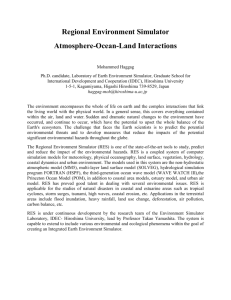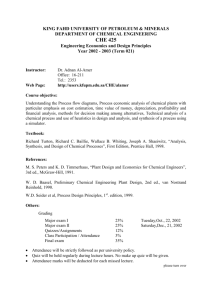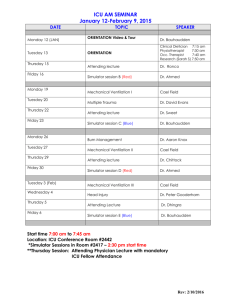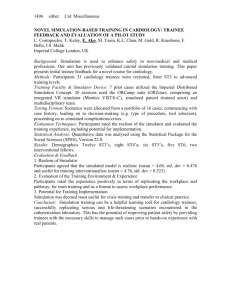1.1. What is BAMA simulator?
advertisement
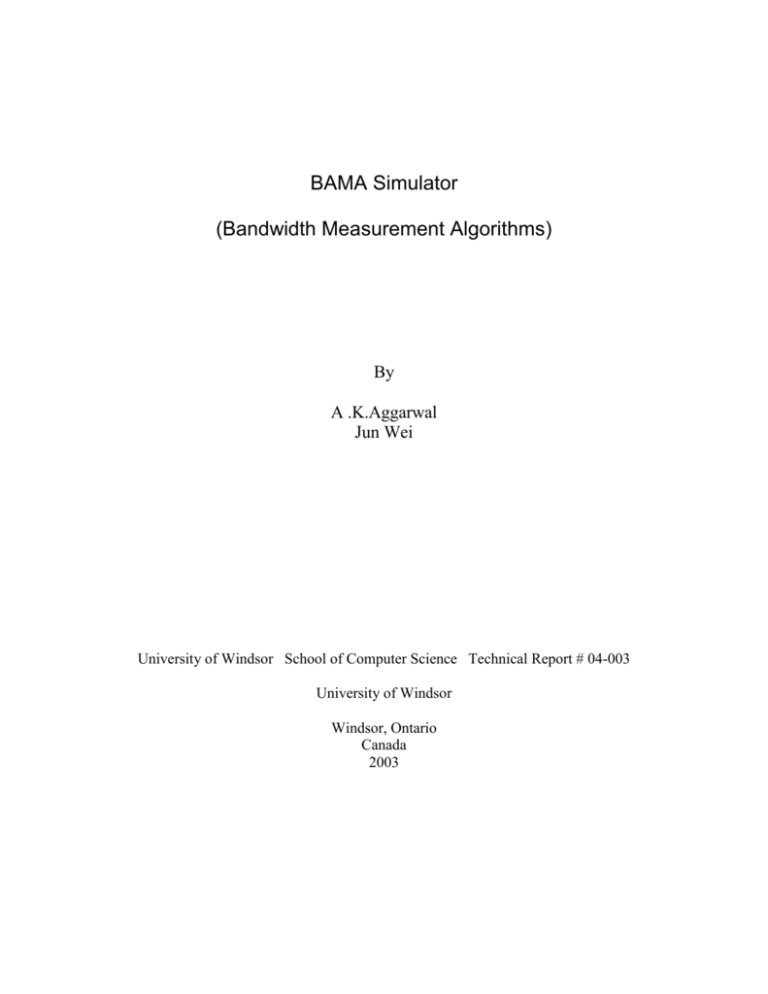
BAMA Simulator (Bandwidth Measurement Algorithms) By A .K.Aggarwal Jun Wei University of Windsor School of Computer Science Technical Report # 04-003 University of Windsor Windsor, Ontario Canada 2003 Abstract As greater numbers of people and companies implement their business using Internet, the measurement of network bandwidth, especially the bottleneck-link bandwidth, becomes a critical and challenging issue. To verify and improve upon the PATH (PAcket-Train with Header) algorithm, we have developed a user-friendly tool: BAMA (BAndwidth Measurement Algorithms) simulator. It can simulate most network bottleneck bandwidth algorithms. By using this BAMA simulator and Network Simulator to implement the PATH algorithm and compare it with the other algorithms, we prove that, under heavy cross traffic, PATH is more accurate than existing sender-based algorithms. Keywords: Bottleneck link bandwidth, single packet, packet pair, packet train, PATH Abstract ............................................................................................................................... 2 1. Introduction ................................................................................................................. 4 1.1. What is BAMA simulator? ................................................................................. 4 1.2. What does BAMA simulator look like?.............................................................. 5 1.3. BAMA simulator parameters .............................................................................. 5 1.4. BAMA simulator flow chart ............................................................................... 7 2. BAMA verification ..................................................................................................... 8 2.1. Bprobe ................................................................................................................. 8 2.2. PATH ................................................................................................................ 10 3. Conclusions ............................................................................................................... 13 References ......................................................................................................................... 14 1. Introduction We developed our own BAMA (BAndwidth Measurement Algorithms) simulator to help develop and adjust the PATH algorithm [Jun Wei Thesis]. It is also used to compare the performance of the PATH algorithm with other algorithms. Then we used Network Simulator [NS], which is a widely used network protocol simulation software, to verify and confirm the result. 1.1. What is BAMA simulator? BAMA simulator is a user-friendly network simulation tool, which is specially designed for testing and tuning of PATH algorithm. The BAMA simulator can implement most of the bottleneck bandwidth estimation algorithms. We have used it to test PATH, BProbe [CC96] and Cartouche algorithm [HBB01]. We used Visual Basic to develop this tool. Users can design their probing structure to measure network bandwidth. BAMA simulator can record the intervals among these probes when they reach the destination and generate an output file. Compared with Network Simulator, BAMA simulator is a user-friendly tool. It is much easier to implement the construction of different probes. But BAMA is specially designed to simulate the network-bandwidth-estimation algorithms. Network Simulator has ability to simulate various network environments and algorithms. 1.2. What does BAMA simulator look like? By using BAMA simulator, in the Figure 1-1, the user can easily set the parameters to implement the bandwidth-estimation algorithms. Figure 1-1 BAMA simulator 1.3. BAMA simulator parameters There are three kinds of parameters in BAMA simulator: router information, packet information, and the cross traffic information. Router/link information In this section, users can enter the following parameters to simulate their algorithms: o The number of routers o Bandwidth: The capacity bandwidth (Kbps) o Latency: The latency of each link (millisecond) o Cross traffic FR: the flow rate of cross traffic (Kbps) from the sender to the receiver direction. Zero means there is no cross traffic o ACK CTFR: the flow rate of cross traffic (Kbps) from the receiver to the sender direction. Zero means there is no cross traffic. Packet information Users can design their own probe schema. For example, user can set: o Packet number: The number of the packets in each run o Packet Size: The size of each packet (bytes) o ACK: If there is ACK packet coming back to the sender o TTL: The TTL value in the header of the packets o Times: how many times the whole packet train (we call it “run”) is sent out from sender. Cross traffic information The minimal and maximum packet size of cross traffic packets (bytes) can be set in this section. Figure 1-2 explains the flow charts of the BAMA simulator. BAMA simulator will save all the configuration parameters into database and generate result files to display the simulation result. 1.4. BAMA simulator flow chart Begin Initialize the bandwidth, latency, and packet array. Read router, packet, cross traffic information Save configuration parameters into database Calculate arrival time, departure time and available time for each packet and each router Analyze and calculate the interval between packets Generate the result file END Figure 1-2 BAMA flow chart 2. BAMA verification We used Network Simulator [NS] to verify the BAMA simulator. Based on the same parameters, we used the BAMA simulator and Network Simulator respectively to implement the network-bandwidth estimation algorithms, such as BProbe and PATH algorithm. By comparing their estimation results, we can validate the BAMA simulator. By using BAMA and Network Simulator, we tested two network bandwidth estimation algorithms: BProbe and PATH. 2.1. Bprobe We used BAMA and NS to implement BProbe algorithm respectively. The network parameters can be found from Table 2-1. Link 1 Link 2 Link 3 Link 4 Link 5 Link 6 Link 7 Link 8 Link 9 Link 10 Link 11 Link 12 Link 13 Link 14 Bandwidth (bps) 2M 622 M 10 M 2M 5M 10 M 16 M 51 M 2M 1.544 M 10 M 16 M 622 M 2M Table 2-1 BProbe parameters Latency 10ms 10ms 10ms 10ms 10ms 10ms 10ms 10ms 10ms 10ms 10ms 10ms 10ms 10ms Cross traffic flow rate (bps) 0 0 0 0 4.5 M 0 0 0 0 0 0 0 0 0 By using Network Simulator, the 77.78% of bottleneck-bandwidth estimates are 1.54M, which is the real value of the bottleneck bandwidth. BAMA simulator gets the 77.78% accurate result too. The histograms of the results are shown on the Figure 2-1 and Figure 2-2. The bin width is 0.068 Mbps. We can see that the distributions of the estimation results are similar and the accuracy of estimation is same. Figure 2-1 Network Simulator estimation distribution Figure 2-2 BAMA simulator estimation distribution 2.2. PATH Another experiment to verify the BAMA simulator is implementing PATH algorithm on both simulators. Table 2-2 shows the parameters we used: Link 1 Link 2 Link 3 Link 4 Link 5 Link 6 Link 7 Link 8 Link 9 Link 10 Link 11 Link 12 Link 13 Link 14 Bandwidth (bps) 2 Mb 622 Mb 10 Mb 2 Mb 5 Mb 10 Mb 16 Mb 51 Mb 2 Mb 1.544 Mb 10 Mb 16 Mb 622 Mb 2 Mb Table 2-2 PATH Parameters Latency 10ms 10ms 10ms 10ms 10ms 10ms 10ms 10ms 10ms 10ms 10ms 10ms 10ms 10ms Cross traffic flow rate (bps) 200 k 200 k 200 k 2500 k 6000 k 200 k 200 k 200 k 200 k 200 k 200 k 200 k 200 k 200 k To estimate the bottleneck bandwidth, Network simulator can get 97.92% accurate result and BAMA simulator gets 98.45%. The distributions of the estimation of these two simulators are quite similar. Figure 2-3 and Figure 2-4 show the histogram of the estimation result. From the experiments we have discussed, BAMA simulator can get almost the same result as the Network Simulator. Bandwidth Frequency (kbps) Less than 300 86 300 - 400 8 400 - 500 10 500 - 600 3 600 - 700 4 700 - 800 4 800 - 900 4 900 - 1000 9 1000 - 1100 2 1100 - 1200 0 1200 - 1300 0 1300 - 1400 1 1400 - 1500 3 1500 - 1600 7866 Great than 1600 0 Total 8000 Figure 2-3 The estimation result of Network Simulator Bandwidth Frequency (kbps) Less than 300 4 300 - 400 99 400 - 500 9 500 - 600 5 600 - 700 11 700 - 800 14 800 - 900 21 900 - 1000 10 1000 - 1100 5 1100 - 1200 1 1200 - 1300 0 1300 - 1400 0 1400 - 1500 0 1500 - 1600 8385 Great than 1600 0 Total 8564 Figure 2-4 The estimation result of BAMA simulator 3. Conclusions To verify our new bottleneck link-bandwidth estimation algorithm: PATH, which is a sender-based algorithm and straightforward to implement in the Internet, we have developed the BAMA simulator. BAMA is a user-friendly tool to simulate most network bottleneck bandwidth algorithms and to verify and improve the PATH algorithm. References [CC96] R. L. Cater and M. E. Crovella, Measuring Bottleneck Link Speed in PacketSwitched Networks Performance Evaluation, Vol. 27-8, pp. 297-318, Oct. 1996 [HBB01] K. Harfoush, A. Bestavros, and J. Byers, Measuring Bottleneck Bandwidth of Targeted Path Segments Technical Report BUCS-TR-2001-016, Boston University, Computer Science Department, July 2001 [Jun Wei Thesis] Jun Wei, Bottleneck Bandwidth Measurement Using PATH Algorithm (thesis) [NS] Network Simulator (NS), version 2 (website) http://www.isi.edu/nsnam/ns/

